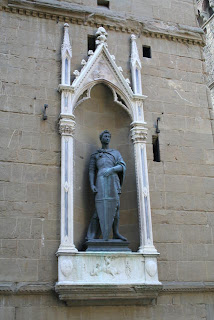When Brunelleschi's Cupola was built, timber frameworks surrounded the cathedral. The north side of the Duomo faces via de' Servi, and in one of these apartmente a young and nice taylor lived and worked, who sometimes came to the window to get more light, or simply to look at the men working at the cupola, when her husband wasat w ork. A love story started, and one of these stone carvers sculpted a head of a cow, with a big pair of horns, facing the balcony of the young girl maybe to warn her husband.
Well, this is what people said....But the reason of the head of a cow sculpted on top of the frames at the base of the cupola is probably another one: maybe it is just to say thanks to these animals that made possible such a great work!
Sunday, April 24, 2011
Tuesday, April 19, 2011
Volonteering in Boboli Garden
When I am not busy with guiding, my favourite target is Boboli Garden at the back of Pitti Palace. It's the prototype of the Italian garden.Vast and tidy, geometrically arranged, it's the realm of immagination. Everything looks natural though it was shaped by the skillful hands of marvellous architects in the 16th century. A maze of lanes sided with baybush suddenly open up to show large ponds populated by gods of marble. Pritty woods lead to the orangerie that boasts one of the largest collection of citrus plants. There I help the stuff with the hard work that a vast garden like this requires: pruning the roses and tying the grape branches in the vineyard, weeding the flowerbeds and cleaning the orangerie. I learn how to take care of plants and its great fun! Better than going to the analyst: you go back home relaxed and full of flowers.
Saturday, April 16, 2011
St. George
Soon it will be St. George's Day!
He's not one of the typical, traditional saints of Florence, but the legend of Saint George slaying a dragon dates from the twelfth century and at the beginning of the fifteenth century he was the patron saint of the "Arte degli Armaioli" . Donatello represented him as a young man, standing so proud in one of the niches around the Orsanmichele Church (see the originat at the Bargello museum).
Saint George was also represented above the city gate of San Giorgio, the beautiful relief representing him has been replaced by a copy, and the original is now in the Palazzo Vecchio Museum.
Saint George became the patron saint of England in the thirteenth century. He died ca. 300 as a martyr, decapitated, as he had refused to worship pagan gods as the emperor ordered.
He is celebrated on 23 April, and he is regarded as one of the most prominent military saints. No special event on this day in Florence but just his memory and images in Florence and around...Many foreigners passing through Tuscany since the Middle Ages had probably made St. George so familiar to us.
B
He's not one of the typical, traditional saints of Florence, but the legend of Saint George slaying a dragon dates from the twelfth century and at the beginning of the fifteenth century he was the patron saint of the "Arte degli Armaioli" . Donatello represented him as a young man, standing so proud in one of the niches around the Orsanmichele Church (see the originat at the Bargello museum).
Saint George was also represented above the city gate of San Giorgio, the beautiful relief representing him has been replaced by a copy, and the original is now in the Palazzo Vecchio Museum.
Saint George became the patron saint of England in the thirteenth century. He died ca. 300 as a martyr, decapitated, as he had refused to worship pagan gods as the emperor ordered.
He is celebrated on 23 April, and he is regarded as one of the most prominent military saints. No special event on this day in Florence but just his memory and images in Florence and around...Many foreigners passing through Tuscany since the Middle Ages had probably made St. George so familiar to us.
B
Subscribe to:
Comments (Atom)



